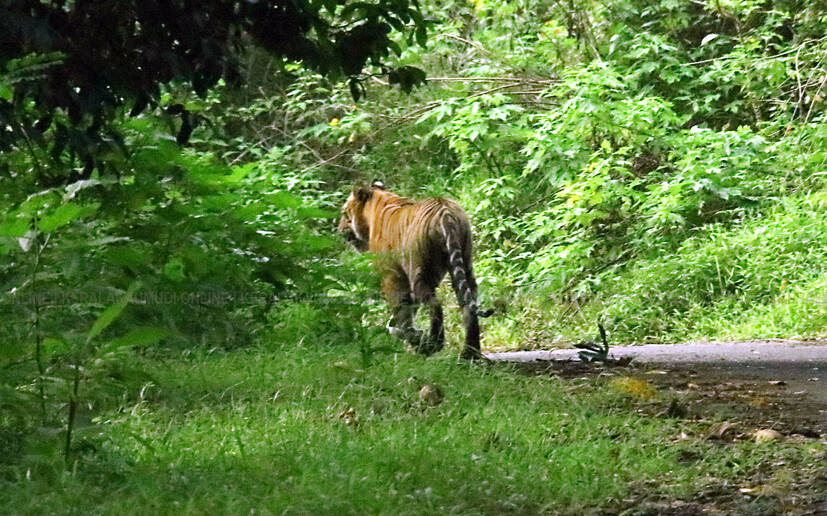Gavi in Kerala is currently a part of the Periyar Tiger Reserve, regarded as the first among well-conserved forest regions in the country.

A tiger in Kerala's Gavi on June 12 (South First)
The pristine and ecologically sensitive Gavi forest region in Pathanamthitta district is likely to be declared the third tiger reserve of Kerala very soon, with the Union Ministry of Environment, Forests, and Climate Change agreeing to a proposal from the state’s Forest Department.
Gavi is currently a part of the Periyar Tiger Reserve, one of the most well-conserved forest regions of India.
Gavi and its surrounding forests, with an estimated tiger population of 13, will now be brought under a different administration.
The Parambikulam Tiger Reserve, which shares a border with Tamil Nadu’s Anamalai Tiger Reserve, is the other reserve in Kerala.
Unlike most other parts of Kerala, Gavi has very little human presence, and hardly 500 people live within the limits of the proposed tiger reserve, which would span 378 square kilometres.
Kerala Forest Development Corporation (KFDC) managing director Prakriti Srivastava told South First that the 500 people there hail from around 160 families of Tamil repatriates from Sri Lanka. They are presently employed in a tea estate owned by KFDC in the heart of the forest.
Once the Kerala region gets tiger reserve status, the estate will have to wind up its operations.
On its part, the corporation has agreed to go by the Union ministry directive and started a survey among the 160 families to know if they are ready to relocate if a proper rehabilitation package emerges.
According to KV Sajeer, divisional manager of the KFDC in Gavi, a dozen families have officially expressed their willingness by responding to the survey, and the rest have communicated informally that their only concern was the relocation package.
V Kanthaswamy, one of those living and working in Gavi, told South First that the only demand on the part of the families is that they must be adequately compensated.
“Initially, officials asked us whether we would be happy with a total ₹10 lakh package. We told them that amount is very meagre. If the government can address our concerns of proper houses and livelihood outside other than a considerably well-compensated amount, we are ready to move out,” he said.
According to Kanthaswamy, the younger genera
tions in the families are against continuing within the forest environment where the animal population is increasing.
“In addition, the new generation needs internet connectivity, schools, colleges, healthcare, and transport facilities. In Gavi, we will not get any of these,” he explained.
Srivastava said high-level discussions are underway to evolve a comprehensive rehabilitation package that would help relocate the families from Gavi, facilitating easy movement of tigers and other animals.
The forefathers of the repatriates went from Tamil Nadu to Sri Lanka to work in newly created tea plantations of British entrepreneurs in the 18th century. After independence in 1948, the island country did not want them there.
As per a treaty between India and Sri Lanka, a sizable population of the affected families has been taken back and accorded citizenship.
Southern states with hill regions created tea estates in the 1970s to accommodate these families, and the KFDC estate and tea factory in Gavi are part of that.
Identified as a much-sought-after eco-tourism destination in the country, Gavi has some KFDC facilities to accommodate tourists who love its scenic beauty.
Other than tigers, it has 43 elephants.
It is also a connecting link between the Thekkady, Pathanamthitta, Achankovil, Thenmala, Punalur, and Senthuruni forest regions.
Endangered species like the Nilgiri tahr and lion-tailed macaque can be sighted in abundance here.
Gavi further has 260 species of birds, including the great pied hornbill, woodpecker, and kingfisher. It is known as a haven for birdwatchers.
As per data from the forest department, Kerala has 192 tigers, and the majority of them live outside the two existing tiger reserves.
Though not a tiger reserve, the Wayanad forests are home to the largest number of tigers in Kerala, with their population ranging between 75 and 80.
Though there were attempts to declare Wayanad the third tiger reserve of the state in recent years, the move evoked stiff opposition from the robust settler community there. So the authorities have shelved the move, at least for the time being.

Apr 18, 2024

Apr 18, 2024

Apr 18, 2024

Apr 18, 2024

Apr 18, 2024